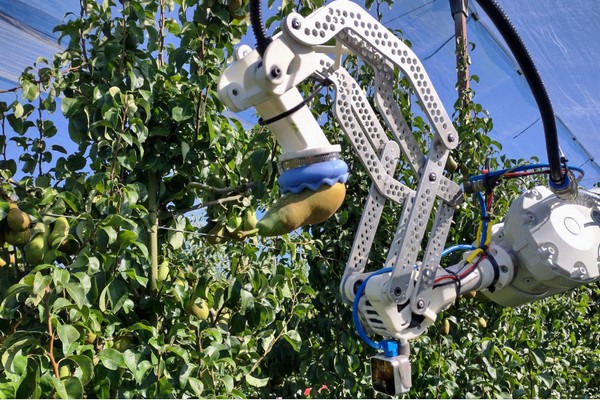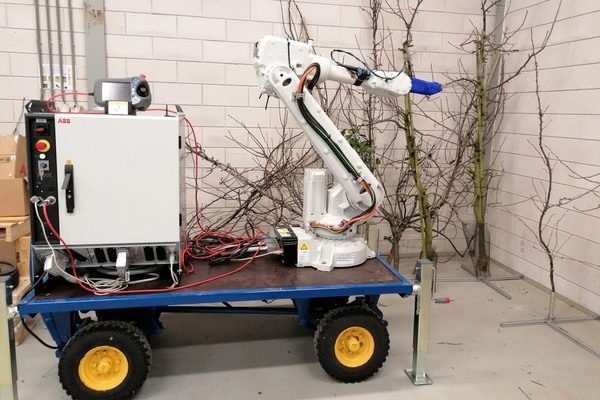The Next Fruit 4.0 project involves around 35 partners, all working to advance the development of technological solutions for precision fruit cultivation. Key themes for the project include digitalization, precision crop protection, labor optimization, robotization, and, above all, profitability.
The project is divided into six work packages:
- Sensing
- Management information
- Robotization
- Preconditions
- Implementation, economic validation, and innovation adoption
- An innovation circle
In practice, this means detecting trees, branches, fruits and blossoms for the purpose of precision crop protection, for example. It also includes the use of sensor technology to detect stress, disease, and pests and to monitor crops and products (both pre-harvest and post-harvest). It means using grippers for the roboticised pruning and harvesting of pears, particularly and the pruning of redcurrant bushes.
Grippers for robotic pruning and harvesting
Dr. Jochen Hemming, senior research associate in computer vision and robotics at WUR's Vision + Robotics program, is responsible for the robotization work package and explains why pears and redcurrants were chosen specifically. "At the global level, there's a relatively strong focus, both scientifically and commercially, on robots for picking apples. But the harvest period in the Netherlands is just six to eight weeks, and in fact more pears than apples are now grown in Benelux. Also, the project is being funded by fruit growers who are members of the NFO, as well as the top sector of Horticulture & Propagation Materials and the Dutch industry. So, for all those reasons, pears were chosen. As part of the cost minimization aspect of the project, we're looking at multifunctional applications of robots and grippers, so it makes sense to look at pruning as well as harvesting. A shortage of qualified workers is making it increasingly difficult to perform both of those tasks. And because the participating fruit growers include redcurrant growers, the scope was broadened to the pruning of redcurrant bushes. The sensorics – meaning the combination of cameras, sensors and grippers – are very complex for both of those types of pruning, which is why the researchers at The Next Fruit 4.0 are collaborating with researchers at the Digital Orchard programme at OnePlanet."
Hemming is incidentally one of the few researchers within Vision + Robotics, focusing specifically on robotic arms and grippers. Most of the other researchers focus mainly on machine vision, artificial intelligence (AI), and spectral image analysis.

A shortage of qualified workers is making it increasingly difficult to perform both of those tasks. And because the participating fruit growers include redcurrant growers, the scope was broadened to the pruning of redcurrant bushes. The sensorics – meaning the combination of cameras, sensors and grippers – are very complex for both of those types of pruning, which is why the researchers at The Next Fruit 4.0 are collaborating with researchers at the Digital Orchard programme at OnePlanet."
The search for an affordable camera
Just like in the Digital Orchard program, the problem for Hemming is that mature industrial technologies are not always entirely suitable and sufficiently robust for agricultural applications. This applies to robotic arms, sensors, and computers. Moisture, dust, light/sunlight, and temperatures below 5 degrees Celsius seem to pose the biggest challenges. That's an issue because pruning is often done during colder periods with high humidity.
"Roboticising secateurs isn't the problem. We managed that pretty quickly. But detecting which branches need to be pruned is proving much more challenging than we initially thought. The obvious choice of technology for this is a stereo camera, such as the familiar and affordable Intel RealSense or StereoLabs ZED cameras. These are appropriate in terms of their cost and computing power, but they struggle when it comes to recognizing thin objects such as twigs and support wires and dealing with direct sunlight and moving branches and fruits. Alternative cameras are generally too expensive in this context. Meanwhile, LiDAR sensors generate a lot of data that can't easily be processed in real-time. LiDAR data also doesn't include color information, which is often essential for identifying ripe fruits or the type of wood to be pruned. We looked at and were offered quite a few cameras, such as the apiCAM from the start-up photonicSENS or Photoneo's high-resolution 3D camera. But the search for the most suitable camera is still ongoing. What we need are sensorics that can detect and distinguish both depth and colour, and can deal with the aforementioned practical challenges of orchards. Ideally, the camera should be priced at less than €1,000."
The extra challenge of pruning currant bushes
To a consumer, pruning a pear tree may seem similar to pruning a redcurrant bush. Industry insiders know that's not the case, and Jochen Hemming now knows it too.
"One of the big issues is that branches belonging to adjacent berry bushes will grow through each other. Identifying the specific structure of a bush is proving challenging in terms of vision and robotics, because the sensorics and underlying algorithms need to determine which branch belongs to which bush. If you can do that, pruning a berry bush is actually easier than pruning a pear tree. The technique used by fruit growers to prune berry bushes is less specific and targeted than the method used for pear trees. From a technological perspective, we're ready to take on challenges that we wouldn't have considered possible five to 10 years ago. This is partly because we now have greater computing power and, in particular, because we now have artificial intelligence and deep-learning algorithms." Hemming is also looking at how the sensor set developed by OnePlanet for the Digital Orchard might help with the development of suitable sensorics.

Decoupling sense and act?
One possible way of decoupling data collection from actual pruning is to do the detection (sensing) in a first pass. The data can then be processed centrally so that you're not constrained by computing power. Using algorithms and, if necessary, input from pruning experts, you can then generate a pruning prescription map for a second pass. "This way, you solve two challenges at once. You're less constrained in terms of computing power and data processing, and you no longer have to decide within a split second what to prune and how to do it. The flip side, however, is that circumstances may have changed between the time of observation and the time of pruning. Not so much in terms of the trees or bushes themselves, but in terms of the weather and wind."
Successful robotic harvest of pears
Turning our attention away from robotic pruning and back to the robotic harvesting of pears, last autumn, researchers and private sector partners successfully harvested the first Conference pears with the use of a robotic arm at the Randwijk research lab, WUR's research site for fruit cultivation. Jochen Hemming spoke about this at the NFO Science Day.
"To pick an apple, the robot arm performs a twisting and pulling motion using its gripper and suction nozzle. But to pick a pear, the robot arm has to perform an upward picking motion. We do this through a lifting motion using a mechanism integrated into the gripper. It's an important and crucial innovation and means the robotic arm doesn't have to perform that lifting movement itself."
"Speaking of robotic arms, I've detected gradually growing interest in agriculture and horticulture among major manufacturers such as ABB Robotics and Kuka. They are open to agricultural applications but still find this a complex environment to navigate. The Japanese company Denso, for example, is enthusiastic and also already active in agriculture and horticulture: they have a robot for harvesting tomatoes in greenhouses, for example."
Industry needs are shifting towards knowledge
Hemming and his team have noticed a gradual shift in what industry and machine manufacturers want, moving away from technology itself and more towards knowledge. "That includes agronomic knowledge, such as an awareness of the best pruning strategy. But they also need to understand the return on investment calculations with regard to automation and robotization. And knowledge of crop growth models, digital twins and simulation. This might include a dynamic crop growth model in 3D and predicting where an apple or pear will grow. I think we at Vision + Robotics, powered by WUR, are the ideal partner for private sector actors in that sense because we can make the connection between the plant, modeling and artificial intelligence, and robotics."
Source: visionrobotics.eu
